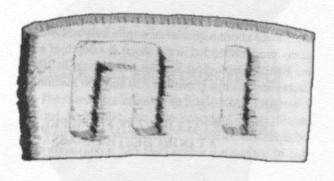Other Finds
Artifacts From AIX En Provence, FranceIn his book Mineralogy, Count Bournon recorded an intriguing discovery that had been made by French workmen in the latter part of the eighteenth century. Bournon wrote: "During the years 1786, 1787, and 1788, they were occupied near AIX en Provence, in France, in quarrying stone for the rebuilding , upon a vast scale, of the Palace of Justice. The stone was a limestone of deep grey, and of that kind which are tender when they come out of the quarry, but harden by exposure to the air. The strata were separated from one another by a bed of sand mixed with clay, more or less calcareous. The first which were wrought presented no appearance of any foreign bodies, but, after the workmen had removed the ten first beds, they were astonished, when taking away the eleventh, to find its inferior surface, at the depth of forty or fifty feet, covered with shells. The stone of this bed having been removed, as they were taking away a stratum of argillaceous sand, which separated the eleventh bed from the twelfth, they found stumps of columns and fragments of stone half wrought, and the stone was exactly similar to that of the quarry: they found moreover coins, handles of hammers, and other tools or fragments of tools in wood. But that which principally commanded their attention, was a board about one inch thick and seven or eight feet long; it was broken into many pieces, of which none were missing, and it was possible to join them again one to another, and to restore to the board or plate its original form, which was that of the boards of the same kind used by the masons and quarry men: it was worn in the same manner, rounded and waving upon the edges."Count Bournon, continuing his description, stated: "The stones which were completely or partly wrought, had not at all changed in their nature, but the fragments of the board, and the instruments, and pieces of instruments of wood, had been changed into agate, which was very fine and agreeably colored. Here then, we have the traces of a work executed by the hand of man, placed at a depth of fifty feet, and covered with eleven beds of compact limestone: everything tended to prove that this work had been executed upon the spot where the traces existed. The presence of man had then preceded the formation of this stone.
Source: FORBIDDEN ARCHEOLOGY, The Hidden History of the Human Race, by Michael A. Cremo and Richard L. Thompson, published by Bhaktivedanta Book Publishing, Inc. There is no better source for additional information and study on this subject than Forbidden Archeology. This remarkable collection of research and analysis is an important work of thorough-going scholarship and intellectual adventure. |


